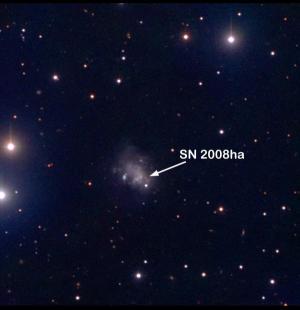
© Stefan Taubenberger, Max Planck Institut for AstrophysicsColour image of supernova SN 2008ha taken on 2008 December 30 at Calar Alto Observatory, with the Zeiss 2.2m Telescope and camera CAFOS. It is a composite of the B, V and R bands. The SN is the faint reddish dot marked with an arrow. The quite irregular shape of the galaxy UGC 12682, that hosts the supernova, is seen at the centre of the image
Core-collapse (or gravitational) supernovae are among the most energetic and violent events in the universe. They constitute the final tremendous explosions that end the life cycles of stars more massive than approximately 8 times the Sun. After running out of fuel, the core of such a star collapses and forms a neutron star or a black hole. At the same time, the outer layers are ejected at high velocity (up to 10% of the speed of light) and shine as brightly as billions of stars together.
The total energy suddenly released by such a typical supernova exceeds the total energy release of the Sun during its whole past and future life time of 10 billion years.
However, some core-collapse supernovae are up to 100 times less energetic and luminous than usual. These low-power explosions normally show the presence of hydrogen gas, but a new event, supernova SN 2008ha, is the first dim supernova in which no hydrogen could be detected. This research has been performed by an international team lead by the Italian astronomer Stefano Valenti (Queen's University in Belfast, United Kingdom), including scientists from Max Planck Institute for Astrophysics (Germany), the National Institute for Astrophysics (Italy), and various other institutions.



